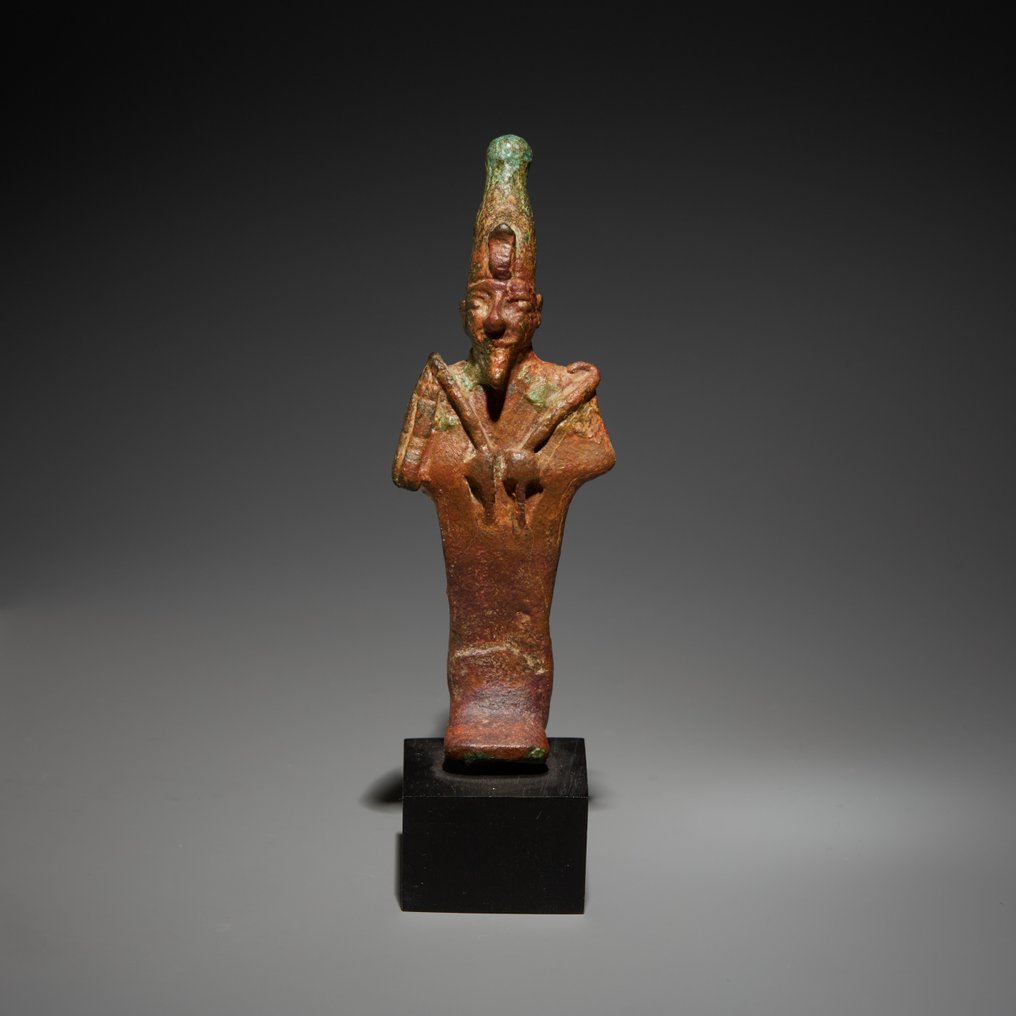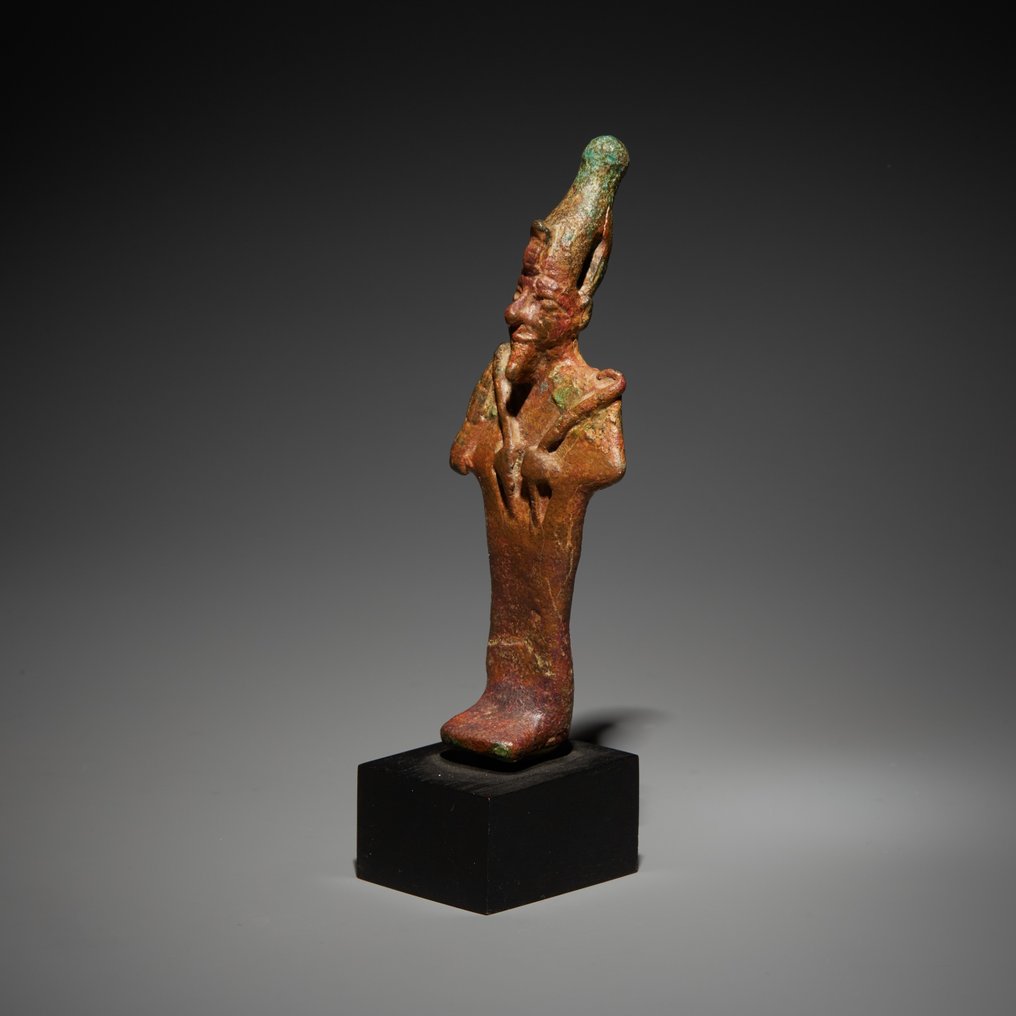Magnífica la entrega y el objeto. Perfecta la sonido del sibato
Fordítás megtekintéseÓkori egyiptomi Bronz Ozirisz. Késői időszak, ie 664-332 10,3 cm magas.
Nr. 88441937



Osiris.
Ancient Egypt, Late Period, 664 - 332 B.C.
MATERIAL: Bronze.
DIMENSIONS: 10.3 cm height and 12.2 cm with the stand.
PROVENANCE:
- Art market, Barcelona.
- Private collection, J. M., Barcelona. Formed at the beginning of the 1960s - 1970s.
- Inherited by his wife C. C., Barcelona.
CONDITION: Good condition.
DESCRIPTION:
Originally, the figure of Osiris was linked to the fecundity of the Egyptian soil, the renewal of vegetation and the world of shepherds, as evidenced by the heka sceptre (which reproduces the shepherds’ crook). He embodied the fertile land and the arable fields, and therefore became the guardian of the order of the universe and the cycles of nature. But the most famous myth concerning him is the one in connection with his death, known through many versions: the son of Geb (the earth) and Nut (the sky) and the husband of Isis, the god primarily was a pharaoh. With Isis, they were a pair of royal benefactors who taught mankind farming and fishing (Osiris), weaving and medicine (Isis). Jealous of the sovereign, his brother Seth assassinated him, cut up his body and disposed of the pieces in the Nile. However, Isis, his wife and faithful widow, found and reassembled the body of her husband and, with the help of her sister, Nephtys, and of Anubis, she embalmed the corpse. After breathing life into him for a short instant, Isis was impregnated by Osiris: this union resulted in the birth of Horus, who, following in the footsteps of his father, became Pharaoh. And so, after having survived the ordeal of death, Osiris triumphed thanks to the magic of his wife and became the ruler of the underworld. He represented the seeds of life and, at the same time, was the protector of the deceased, to whom he would promise life after death.
These two closely related characteristics linking the god of fecundity and the funerary divinity were certainly the basis for the success Osiris enjoyed in the Egyptian world: from the New Kingdom on, and especially during the entire 1st Millennium BC, statuettes of Osiris were among the most important funerary offerings.
The technique of lost wax casting is a sculptural procedure using a mould made from a prototype of the piece to be worked, and this prototype is usually made from beeswax. This is covered with a thick layer of soft material, usually clay, which then solidifies. Once this has hardened it is put in a kiln where the wax inside melts and leaks out through expressly made holes in the clay. In its place molten metal is injected and this takes on the exact form of the mould. To release the final piece the mould must be removed.
Notes:
- The piece includes authenticity certificate.
- The piece includes Spanish Export License (Passport for European Union). NOT TAXES.
- According to Spanish legislation, items sent outside the European Union are subject to export taxes and will be added to the invoice, at the buyer's expense. These export fees are fixed on the final auction price and the tax rate is not applied directly on the total value of the item to be exported, but rather the different percentages by sections are applied to it:
- Up to 6,000 euros: 5%.
- From 6.001 to 60.000 euros: 10%.
This export permit application process can take between 1-2 months maximum.
- The seller guarantees that he acquired this piece according to all national and international laws related to the ownership of cultural property. Provenance statement seen by Catawiki.
Az eladó története
Osiris.
Ancient Egypt, Late Period, 664 - 332 B.C.
MATERIAL: Bronze.
DIMENSIONS: 10.3 cm height and 12.2 cm with the stand.
PROVENANCE:
- Art market, Barcelona.
- Private collection, J. M., Barcelona. Formed at the beginning of the 1960s - 1970s.
- Inherited by his wife C. C., Barcelona.
CONDITION: Good condition.
DESCRIPTION:
Originally, the figure of Osiris was linked to the fecundity of the Egyptian soil, the renewal of vegetation and the world of shepherds, as evidenced by the heka sceptre (which reproduces the shepherds’ crook). He embodied the fertile land and the arable fields, and therefore became the guardian of the order of the universe and the cycles of nature. But the most famous myth concerning him is the one in connection with his death, known through many versions: the son of Geb (the earth) and Nut (the sky) and the husband of Isis, the god primarily was a pharaoh. With Isis, they were a pair of royal benefactors who taught mankind farming and fishing (Osiris), weaving and medicine (Isis). Jealous of the sovereign, his brother Seth assassinated him, cut up his body and disposed of the pieces in the Nile. However, Isis, his wife and faithful widow, found and reassembled the body of her husband and, with the help of her sister, Nephtys, and of Anubis, she embalmed the corpse. After breathing life into him for a short instant, Isis was impregnated by Osiris: this union resulted in the birth of Horus, who, following in the footsteps of his father, became Pharaoh. And so, after having survived the ordeal of death, Osiris triumphed thanks to the magic of his wife and became the ruler of the underworld. He represented the seeds of life and, at the same time, was the protector of the deceased, to whom he would promise life after death.
These two closely related characteristics linking the god of fecundity and the funerary divinity were certainly the basis for the success Osiris enjoyed in the Egyptian world: from the New Kingdom on, and especially during the entire 1st Millennium BC, statuettes of Osiris were among the most important funerary offerings.
The technique of lost wax casting is a sculptural procedure using a mould made from a prototype of the piece to be worked, and this prototype is usually made from beeswax. This is covered with a thick layer of soft material, usually clay, which then solidifies. Once this has hardened it is put in a kiln where the wax inside melts and leaks out through expressly made holes in the clay. In its place molten metal is injected and this takes on the exact form of the mould. To release the final piece the mould must be removed.
Notes:
- The piece includes authenticity certificate.
- The piece includes Spanish Export License (Passport for European Union). NOT TAXES.
- According to Spanish legislation, items sent outside the European Union are subject to export taxes and will be added to the invoice, at the buyer's expense. These export fees are fixed on the final auction price and the tax rate is not applied directly on the total value of the item to be exported, but rather the different percentages by sections are applied to it:
- Up to 6,000 euros: 5%.
- From 6.001 to 60.000 euros: 10%.
This export permit application process can take between 1-2 months maximum.
- The seller guarantees that he acquired this piece according to all national and international laws related to the ownership of cultural property. Provenance statement seen by Catawiki.
Az eladó története
- 823
- 10
- 1
very well packed with all the documents included, thnks
Fordítás megtekintéseGreat object. Really beautiful. Quick delivery. Excellent.
Fordítás megtekintéseSuperbe objet, Service d'Arqueologia Ancient Art excellent et rapide. Jaume Bagot toujours parfait .
Fordítás megtekintéseTodo perfecto gracias
Fordítás megtekintéseNice item all ok A+++
Fordítás megtekintéseThank you for this Oinochoe, one question: did you as promised read my post!
Fordítás megtekintéseVery cooperative in every aspect of the transaction.
Fordítás megtekintéseAlways a great pleasure!
Fordítás megtekintéseFine quality, good service. Thanks.
Fordítás megtekintéseMuy amables, muy bien todo. Gracias
Fordítás megtekintéseAlles bestens
Fordítás megtekintéseexactly as described and shipped safely and punctually.
Fordítás megtekintéseschnelle Lieferung sehr sichere Verpackung alles bestens
Fordítás megtekintésetres bel objet je le recherchai depuis longtemps envoi rapide et protégé je pense qu'il y aura d'autres achats avec ce vendeur merci +++++++
Fordítás megtekintéseEinfach nur toll
Fordítás megtekintéseTodo perfecto
Fordítás megtekintéseottimo
Fordítás megtekintéseperfetto
Fordítás megtekintésetop oggetto bellissimo grazie 💯💯💯💯💯💯 :-)
Fordítás megtekintéseI bought this beautiful artifact together with artifact from Mr. Bagot but although it is clearly stated on his shipping page that when purchasing multiple artifacts i paid the double package costs
Fordítás megtekintéseI bought this beautiful artifact together with artifact from Mr. Bagot but although it is clearly stated on his shipping page that when purchasing multiple artifacts i paid the double package costs
Fordítás megtekintéseBel objet, bien emballé. Parfait.
Fordítás megtekintésewonderful faiece and very fast shipping.thanks a lot
Fordítás megtekintéseJ Bagot es un profesional excelente. Sus artículos son de gran calidad, se incluye la documentación necesaria y el embalaje se realiza con esmero. Le recomiendo encarecidamente.
Fordítás megtekintése- 823
- 10
- 1
Magnífica la entrega y el objeto. Perfecta la sonido del sibato
Fordítás megtekintéseLemondás
Az eladó garantálja, hogy a tárgy a jogszabályoknak megfelelően került hozzá, és ezt bizonyítani is tudja. Az eladó kapott információt a Catawikitől arról, hogy a tárgyhoz mellékelnie kell a tartózkodási helyének megfelelő jogszabályok alapján szükséges dokumentációt. Az eladó garantálja a tárgy eladását/exportját és jogában áll mindez. Az eladó minden a tárggyal kapcsolatban szükséges információt továbbít a vevőnek. Az eladó biztosítja, hogy minden szükséges engedély el lett/lesz intézve. Az eladó azonnal tájékoztatja a vevőt, amennyiben az engedélyek beszerzése késik.
Az eladó garantálja, hogy a tárgy a jogszabályoknak megfelelően került hozzá, és ezt bizonyítani is tudja. Az eladó kapott információt a Catawikitől arról, hogy a tárgyhoz mellékelnie kell a tartózkodási helyének megfelelő jogszabályok alapján szükséges dokumentációt. Az eladó garantálja a tárgy eladását/exportját és jogában áll mindez. Az eladó minden a tárggyal kapcsolatban szükséges információt továbbít a vevőnek. Az eladó biztosítja, hogy minden szükséges engedély el lett/lesz intézve. Az eladó azonnal tájékoztatja a vevőt, amennyiben az engedélyek beszerzése késik.









